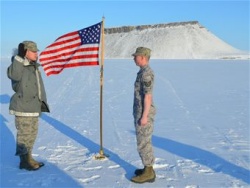Security forces enhances situational awareness with Arctic command, control innovation
The TETRA currently being installed at Thule AB is unique in that, unlike typical first responder systems, it is based on...
Airmen at Thule Air Base are adopting a new land mobile radio system, enhancing their communications capabilities.
Known as Terrestrial-Trunked Radio, or TETRA for short, this LMR
system's employment will result in enhanced situational awareness,
removal of a redundant command and control node, savings of one security
forces post, and enhanced emergency services interoperability across
all 821st Air Base Group agencies. The new system will enhance emergency
services at the remote site.
The security forces' base defense operations center manages a command
and control structure involving numerous first responder agencies across
a massive geographic area encompassing 2,400 acres of real estate. The
installation resides approximately 900 miles south of the North Pole, 15
miles from the polar ice cap, on an inlet to the Arctic Ocean known as
North Star Bay.
The air base's mission requires daily travel exceeding 10 miles across
rocky terrain with significant changes in elevation. Thule AB routinely
experiences hurricane force winds during long and arduous storm seasons
from September through May. As a result, procedures adopted for safety
and mission execution mandate BDOC maintain contact with all personnel
traveling across the installation during contingency storm operations.
In fact, all movement is strictly controlled by the installation
commander due to potential white-out storm conditions resulting from 100
mph winds and the risk to personnel should they lose situational
awareness during their commute.
In all, the security forces squadron maintains communication with a host
of customers, including the squadron's posted forces, Danish police,
and contractor-provided fire and medical response forces, and manages
interoperability between installation senior leaders and four separate
command and control centers. Prior to TETRA, BDOC managed this
requirement across three disparate communications platforms.
The TETRA currently being installed at Thule AB is unique in that,
unlike typical first responder systems, it is based on the UHF
electromagnetic wavelength rather than the typical VHF range. As a
result, it provides greater range and the ability to pierce the dense
walls of Thule's facilities, used to combat the severe environmental
climate. 
The TETRA system provides a suite of capabilities including GPS location
designation for all users, multiple voice-call modes - person to person
or full network broadcast - text capability, and duress annunciation.
As a result, BDOC can maintain communications with all 821st Air Base
Group and Greenland contractor senior leadership, and all non-emergency
and emergency response agencies on one LMR platform.
At the same time, BDOC can visually track - via a digital mapping
display - the location and travel data associated with all personnel in
possession of a new handheld TETRA, and verify the employment of
security forces personnel during all other contingency response
incidents. Finally, the range of this system will allow the primary BDOC
to control all forces across the 2,400 acre Thule defense area.
Many organizations participated in this shift to ensure the first
responder community at Thule AB had a system capable of the significant
geographic coverage and situational awareness necessary to ensure sound
response protocols. The 821st Support Squadron Communication Flight
recognized the technological capability, conducted site surveys and
system testing, and communicated to the Air Force Space Command
Communications and Information Directorate the need and justification
that resulted in approval for a system not previously used.
The 821st Security Forces Squadron plans and programs section
coordinated the re-write of an existing AFI with the AFSPC Security
Forces Directorate to allow for the employment of the new technology.
Finally, identification of the system and its potential occurred as a
result of the communication's expertise that resides within the
Greenland contractor's staff, who is also the primary installer of the
equipment which achieved initial operational capability at the end of
April.
The ability of those involved in the acquisition and employment of TETRA
to break through long-held beliefs about one way to do business has
resulted in a level of situational awareness never before possessed at
Thule AB.
In times of shrinking budgets and reduced manpower, innovation is
critical to the success of force protection initiatives. When dominating
the high ground from a climatically-challenging area like Thule AB,
innovation is vital.
Source: Air Force Space Command

